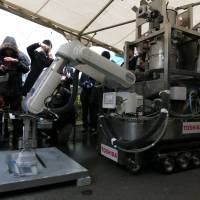Toshiba Corp. on Friday unveiled a prototype of its remotely operated decontamination robot that it expects to help clean up the Fukushima No. 1 plant's radiation-zapped reactor buildings as early as this summer.
The robot — which can withstand radiation up to 100 sieverts, far in excess of what the human body can endure — removes radioactive materials by blasting dry ice onto surfaces including walls and floors. The technology is already utilized to clean the exteriors of airplanes.
The tip of the robot's front arm sprays the dry ice and simultaneously vacuums all of the hazardous substances dislodged. It also comes equipped with a rear compressor to boost its storage space.
Although the pressure at which the dry ice is pounded at surfaces is considered powerful enough to remove radioactive materials, Toshiba's robot won't be able to blast off the epoxy polymers used to paint the floor and walls of the first floor of the reactor buildings, the firm said.
The robot can move at a speed of between 5 and 20 meters per minute, and is able to run on inclines up to 5 degrees. Toshiba has also installed eight cameras in it to facilitate its operation from remote locations.
Toshiba has not conducted a live experiment with actual radioactive materials yet, but it plans to start holding demonstrations at the Fukushima No. 2 nuclear plant and to then begin employing the robot in the field at the No. 1 power station this summer, a company official said.
The idea of using the dry ice spray technology for remote decontamination at the Fukushima No. 1 plant arose from public input, according to Toshiba.


















With your current subscription plan you can comment on stories. However, before writing your first comment, please create a display name in the Profile section of your subscriber account page.